A wide range of factors affects the quality of the air we breathe, but the importance of optimal air humidity for creating a healthy environment is often overlooked. Having humidity control systems explained will help you understand how you can improve air quality in your home or at your office.
It is also important to understand that a low humidity level is as dangerous as a high humidity level because it affects health and causes deterioration of household items.
So, depending on the air’s humidity level in a particular space, your humidity control system can be based around a humidifier or a dehumidifier. In this article, we’ll walk you through the process of choosing the humidity control system that is suited for the space in which you want to install it.
What is Relative Humidity, and how to Measure it?
The first step towards finding a humidity control setup is to understand the concept of relative humidity. This value indicates the amount of moisture content in the air at a specific moment in time.
So, for instance, the relative humidity or (RH) of 100% suggests that the air is completely saturated with water vapor. The RH level in clouds is 100% before the rain, but it is highly unlikely that conditions in a closed space can get so damp that the RH level reaches a hundred percent.
The optimum RH level in a room is between 30% and 50%, and if it drops below 30%, the air becomes too dry, while if the RH level raises over 60%, the room will become too humid.
The simplest way to measure the air’s RH value is to install a hydrometer in a room that will display the current level of moisture content in the air and enable you to know if you should use a humidifier or a dehumidifier.
Mini digital hygrometer/thermometer allows you to easily know the environment temperature and humidity. Great for monitoring family's living conditions and health. Small and light enough for saving space and carrying around.
Recognizing the Symptoms of Low or High Air Humidity
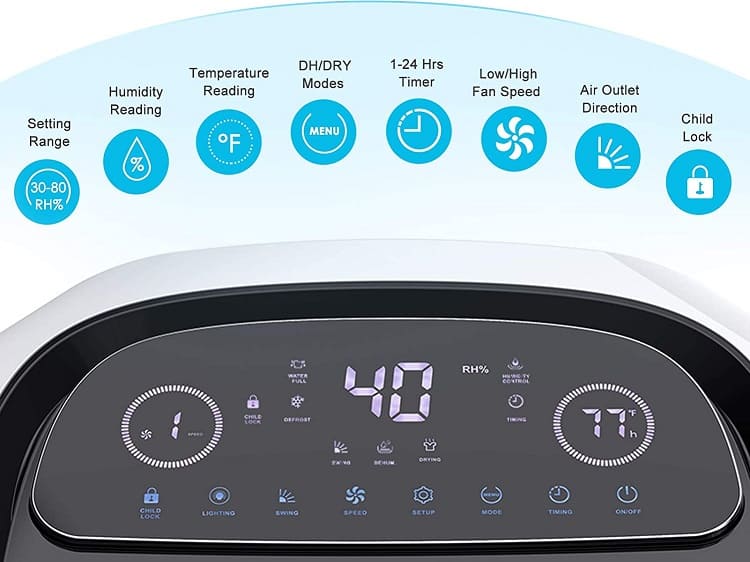
Both dry and humid air can affect your quality of life, as it might cause various health problems. Besides, the air humidity imbalance can damage the floors, walls, and furniture if the issue isn’t addressed promptly.
The most common symptoms of high humidity levels in a room are:
- Stale odors – Rooms that have high levels of humidity in the air have a moldy and unpleasant smell.
- Mold accumulation on the walls – Although it is most common in bathrooms, mold can accumulate on the walls of any room with high air humidity levels.
- Warped wooden surfaces – Prolonged exposure to humid air can be the reason why wooden surfaces warp.
- Moisture condensation on windows – Moisture tends to accumulate on windows or near the door of humid rooms.
- Sweaty pipes and ductwork – Damp room conditions can cause sweating of the pipes and ductwork.
On the other hand, you’ll be able to spot the following symptoms if the air in a room is too dry:
- Static electricity – Low air RH levels can increase static electricity you can feel when putting on your clothes or touching your hair.
- Cracking or splintering of wooden surfaces – Over time, low air humidity will dry up wooden furniture and cause it to crack or splinter.
- High amounts of dust – A quick dust pile-up is one of the sure signs that the air’s humidity level is too low.
- Growth of bacteria – A low concentration of water vapor in the air creates favorable conditions for the growth of bacteria.
Dry and humid air conditions have several health implications, so if the air in a room isn’t humid enough, you might experience allergic reactions, your skin can become itchy, or in some cases, your nose may start to bleed. Besides, dry air increases the risk of virus transmission.
Trouble breathing, nervous system damage, and strong allergic reactions are some of the most common health concerns associated with high air humidity levels.
Types of Humidity Control Systems
Even though air conditioners and heaters help keep the air humidity in balance, they aren’t ideal solutions because they only feature heat sensors. Consequently, neither of these devices can recognize that the air in a room has become too humid or too dry.
The easiest way to keep the air humidity in balance is to get a humidity control system that is equipped with a built-in or a remote humidity sensor, which monitors the RH value and activates the system once the excess moisture content raises too high or drops too low.
It is important to understand that you can’t use the same setup to deal with dry and humid air, so you can build your system around a humidifier or a dehumidifier, depending on your needs.
Humidifiers
A humidifier increases the air humidity above 30%, and it can help keep the air moisture at an acceptable level even when you’re not at home. You can choose from five different types of humidifiers.
- Cool mist humidifiers – By emitting a cool vapor into the air, cool mist humidifiers regulate the RH level without affecting the room temperature.
- Evaporative humidifiers – Low upkeep requirements and self-regulating capabilities make evaporative humidifiers a great fit for all dry air rooms. In addition, the water vapor emitted into the air isn’t heated, which helps keep the room temperature at the same level.
- Ultrasonic humidifiers – Equipped with a vibrating diaphragm that discharges the water vapor into the air, ultrasonic humidifiers let you choose if you want to generate warm or cold mist.
- Warm mist humidifiers – If you’re living in a cold climate, you should consider getting a warm mist humidifier that slightly increases the room temperature.
- Vaporizer humidifiers – Instead of water vapor, these humidifiers release steam into the air. The vapor humidifier can emit cold and warm mist into the air, and you can add inhalants that combat flu-like symptoms into the humidifier.
Dehumidifiers
Unlike humidifiers that add moisture to the air, dehumidifiers are designed to absorb water from the air. The methods these devices utilize to lower the air humidity depend on their type, and you can opt for one of the following options.
- Chemical Absorbent Dehumidifier – Equipped with a desiccant made of silica gel and similar hydrophilic materials, chemical absorbent dehumidifiers are capable of absorbing large quantities of moisture. However, these types of dehumidifiers are ill-suited for cold climates.
- Heat Pump Dehumidifier – These humidifiers are equipped with heat exchange coils, a heat pump, and a fan. The low temperature of heat exchange coils causes water condensation and removes moisture content from the air.
- Dehumidifying ventilator – The device utilizes an extractor fan in combination with a sensor to regulate the air’s level of humidity. Dehumidifying ventilators are commonly used in cold climates because the hot air they generate remains in the room.
The Coverage Area of Humidity Control Systems
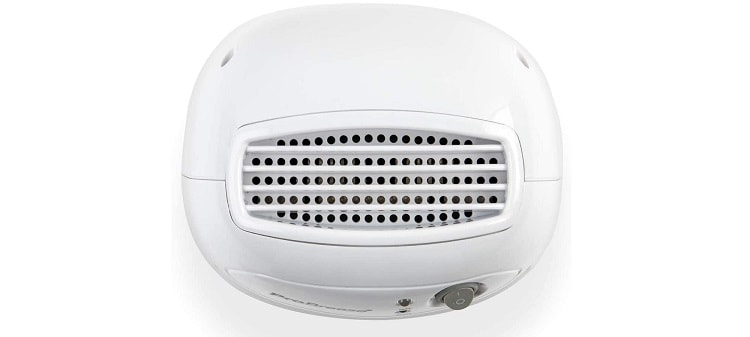
The range of a humidity control system depends on several factors, including the room’s volume and size or the humidification load.
All humidifiers and dehumidifiers are divided into two categories depending on how easy it is to move them. So, let’s take a look at the differences between portable and whole-house humidity control systems.
Portable
A portable humidifier is usually compact and lightweight, and it is relatively easy to relocate it from one room to the other. These devices are often equipped with a built-in moisture sensor that detects if the moisture level is too high or too low and activates the device.
Their coverage area varies between 500sq/ft or less to approximately 2000sq/ft, while the output rating can be limited to 1.5 to 2 gallons per day or exceed 10 gallons per day.
Consequently, the size of the area you’ll be able to humidify or dehumidify with a portable humidity control system depends on the model you choose. In most cases, these devices are designed to regulate the air’s moisture level in one room.
Whole House
As indicated by their name, whole-house humidifiers control the air humidity level in the entire house. You can opt for a self-stranding console model that can cover the area of approximately 3000sq/ft if you want to change the unit’s location often.
In-duct models are connected directly to the home’s duct system, and they can cover areas larger than 6000ft/ft. Although daily moisture output depends on the model, most devices have the capacity to supply more than 10 gallons of moisture per day.
These devices are usually affordable despite high-performance capabilities since you can get a whole-house humidifier or dehumidifier for less than $200.
What’s more, some models can measure the current humidity level, and they can remove or add moisture depending on what the reading shows.
Installing the Moisture Sensor Switch
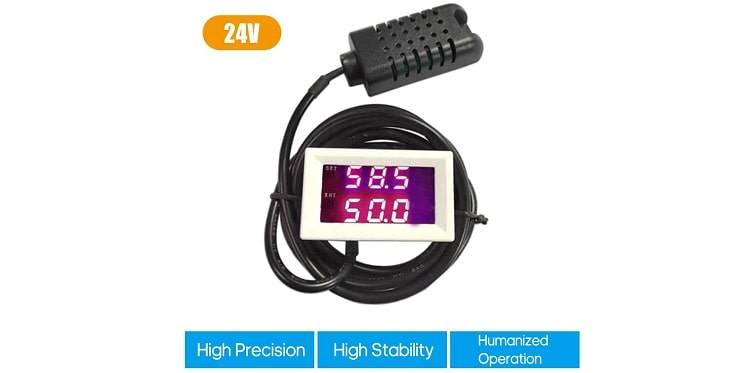
Portable and whole-house humidifiers and dehumidifiers are equipped with built-in moisture sensors that ideally measure the room’s air humidity level.
Although, in theory, this concept sounds great, in practice, the sensors pick up the humidity level in the device’s immediate surroundings, which leads to inaccurate readings.
Installing a moisture sensor switch provides you with a simple solution to the inaccuracies of the built-in moisture sensors. It also allows you to set up an automatic humidity control system that continues working even when you’re not at home.
Fan timer switch dual-tech in-wall humidity control switch that controls both bathroom fan and light simultaneously.
Optionally, you can get a Humidistat Controlled Extractor Fan that enables you to control humidity in a bathroom or a kitchen with a single unit that contains a moisture sensor and a fan.x
The Homewerks Humidity Sensing Exhaust Bath Room Fan is quiet, powerful, and smart enough to detect the moisture levels in the room and automatically turn on once moisture levels reach 60% or higher.
The Most Important Factors to Consider While Choosing a Humidity Control System
A broad spectrum of factors can influence your decision to choose one humidity control system over another.
The climate you live in, whether or not space has an air conditioning system, or the purpose for which the room is used are some of the factors that can affect your choice of the humidity control system.
Besides, you’ll also have to consider the unit’s maintenance requirements because failing to take proper care of a humidifier or dehumidifier can cause malfunction and create air humidity imbalance.
We’ve shortlisted a few of the most important factors you should consider when choosing a humidity control system, so let’s take a look at them.
Find Out if You Need to Increase or Decrease the Air’s Humidity Level
A number of symptoms can indicate that the air humidity level in a room is too high or too low. So, if your eyes become dry while sitting in a room or your throat is sore more often than it usually is, then the air humidity is probably lower than 30%.
In that case, you must get a humidifier that will enable you to raise the moisture content in the air and avoid serious health problems. Rooms that have a musty odor and mold or mildew near the ceiling are probably too humid.
Installing a dehumidifier in that room will help you get rid of the odors and slow down the deterioration of the furniture made of wood. Instead of looking for signs of high and low humidity, you can simply get a hydrometer and measure the air’s moisture level.
The Coverage Area
All humidifiers and dehumidifiers have a projected coverage area, so checking the size of the apartment or a room is the best way to check if a particular model meets your requirements.
However, it would be best if you took the projected area values with a grain of salt because they often don’t reflect the unit’s performance capabilities. That’s why it is better to get a model that has a projected coverage area of 600sq/ft if you want to humidify or dehumidify a 500sq/ft room.
You should also pay attention to the humidifier’s output rating, as it will enable you to know how much moisture it can supply in a day.
Sensor Location
Homeowners who don’t want to depend on the unit’s built-in moisture sensor can get a sensor connected to the unit either by a cable. It is important to keep the two devices at least several feet away from each other to avoid inaccurate air humidity readings.
It is also not advisable to install sensors near doors or windows, as they may pick up the humidity of the air outside of the room. Consequently, the best place to install a moisture sensor is in the middle of a wall where the outside air cannot reach it easily.
Installation Requirements
Setting up an automatic humidity control system can be complex, especially if it involves connecting a whole-home humidifier to the ductwork.
Portable humidifiers and dehumidifiers can just be plugged into a power outlet or even connected to a wireless moisture sensor, so it won’t take you much effort to get them up and to run.
On the other hand, the installation process of the whole house system might require running wires through the walls, so it might be better to hire a professional electrician to hook up the system if you don’t feel comfortable tinkering around electrical installations.
The Cost of a Humidity Control System
You can spend between a few hundred and a few thousand dollars on a new humidity control system. Whole-house humidifiers and dehumidifiers can are the most expensive part of the system, especially if they have high output ratings and coverage area.
Even though they’re not extremely expensive, moisture sensors still add to the entire setup cost because you have to spend between a hundred and two hundred dollars to get them.
You should also factor in the installation costs if you hire an electrician to hook up the whole-house humidifier or dehumidifier.
The Advantages of Humidity Control Systems
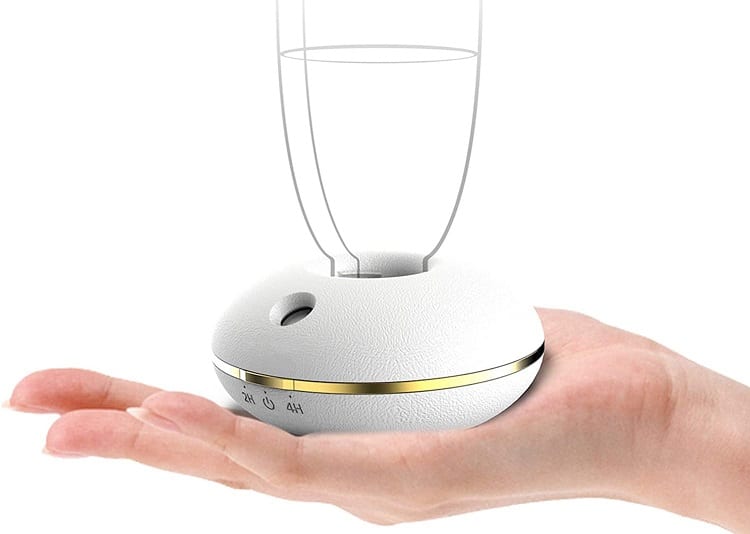
Maintain the Same Humidity Level in the Entire Space
Unlike portable units, whole-house humidifiers and dehumidifiers can keep the air humidity at the optimum level in spaces that are larger than 6.000 sq/ft. What’s more, some models have the ability to both reduce and increase the air’s RH level.
Preserve the Objects in a Room
Wood or metal deteriorate faster in humid conditions, which is the reason why floors, doors, windows, and all other furniture in a room last longer if they’re kept in rooms that have optimal air humidity levels.
Get Rid of the Dust
Maintaining the air humidity in the 30% to 50% range will slow down the dust accumulation in your apartment and reduce the chances of strong allergic reactions. Some models even allow you to add essential oils that can help combat flu-like symptoms.
Long Lifespan
Most whole-home humidifiers remain in good condition for a decade or longer, so you won’t have to replace the unit you choose often. That’s why it is a good idea to invest in a good humidity control system since you’ll use it for a long time.
Lowers the Household’s Energy Consumption
The same temperature feels warmer at a higher humidity level than at a lower level of humidity. So, if the room temperature is at 75F and 50% humidity, it will feel warmer than a room with 30% air humidity and a temperature of 75F.
That’s why you can reduce the amount of energy you’re spending on powering a heater by increasing the air humidity level.
The Disadvantages of Humidity Control Systems
High Upkeep Requirements
Connecting a whole house humidifier to the duct system can cause mold and mildew accumulation in the duct pipes. Consequently, you will have to clean both the humidifier and the duct system frequently to keep it in good condition.
The Installation Process can be Complicated
Even though some portable humidifiers and dehumidifiers can have an impressive coverage range, they still can’t offer the same coverage as the whole house models connected to the air conditioning or heating system.
However, installing the whole house humidifier can require running wires through walls and adjusting the electric installations.
Top 4 Humidity Control Systems
The system you should choose depends on the size of the space in which you want to regulate the humidity level. Besides, the quality and capabilities of the system you can get are also determined by the model’s coverage area.
So, if you need a humidifier or dehumidifier that can cover an area of up to 2000sq/ft, you should opt for a portable model. In case you need more coverage, you should choose the whole house setup.
That’s why it is hard to say which humidity control system is the best, but we’ve selected a few models that might be a good fit for different contexts. Let’s take a look at what they have to offer.
Air Care HD 1409 Whole House Humidifier
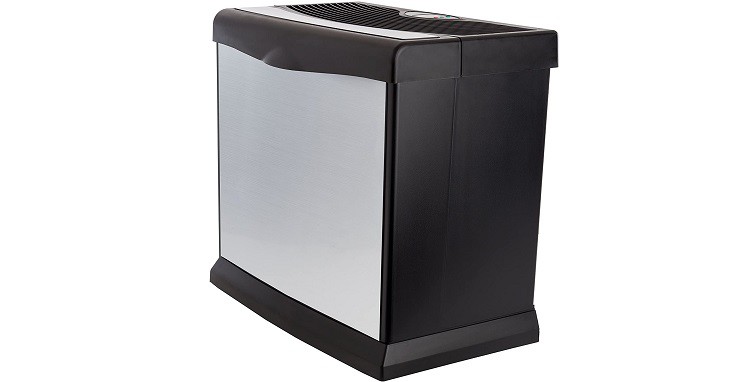
With the capacity to humidify spaces up to 4000ft for 55 hours on a single charge, the Air Care HD 1409 Whole House humidifier. The model is also equipped with a built-in sensor that measures the actual humidity level and shows the results on display.
You can also adjust the desired humidity level or fan speed directly from the display, and the unit will shut down once it reaches the requested level of air humidity. This Air Care model is equipped with a refill indicator that informs when the water supply starts to run low.
The Valiant evaporative humidifier is the perfect choice for the whole house humidification. It humidifies up to 4,000 square feet for up to 55 hours on a single fill.
Colzer 140 Dehumidifier
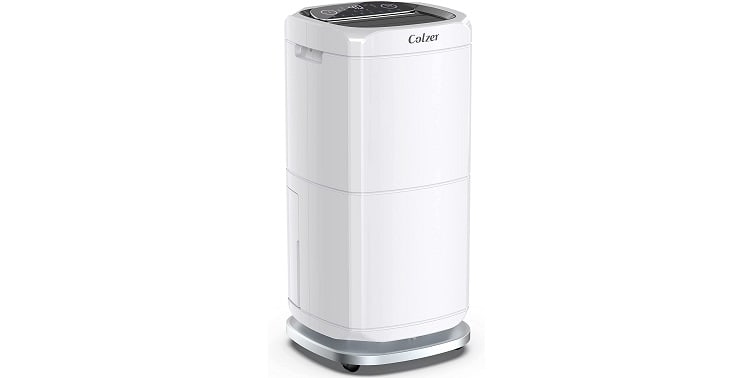
Although it is portable, the Colzer 140 Dehumidifier has impressive output capacity and coverage area. The single unit can lower air humidity in a 6.000sq/ft area and absorbing up to 140 pints of air moisture in a day.
You can choose between two drain options, and you can either opt for a 17-pint reservoir that features a full tank alert and automatic shutdown that prevents overflow or the continuous drainage option using a 6.56ft hose.
This unit features a timer that enables you to program it to regulate the air humidity in your home even while you’re away.
Capable of removing 140 Pints of moisture from the air per day (twice as 70 pints of dehumidifier), this commercial-grade dehumidifier is an ideal drying solution for large basements and any other wet areas up to 6,000 sq ft.
Pro Breeze Portable Electric Dehumidifier
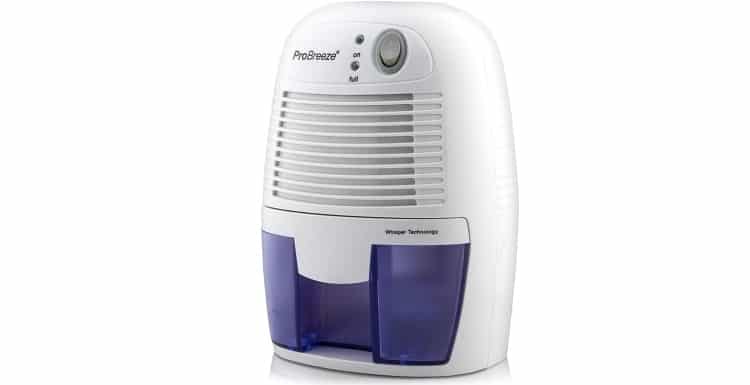
Despite having a storage capacity of just 16oz, the Pro Breeze Portable Electric Dehumidifier can still cover the floor area of 150 square feet. In addition, this model has the capacity to absorb air moisture from spaces smaller than 2200 cubic feet.
Its airflow capacity is 12 CMPH while its optimal operating temperature ranges between 59F and 89F, and it doesn’t work at temperatures below 41F. This mini electric dehumidifier can store up to 9 oz of moisture every day, so you have to empty its 16oz tank after a day and a half of continuous operation.
Compact and Portable, Capable of removing up to 9 ounces of water per day with a 16-ounce water tank capacity. Ideal for rooms 1200 - 2200 cubic feet (215 sq ft).
Fancii Cool Mist Portable Mini Humidifier

The Fancii Cool Mist Portable Mini Humidifier offers a simple way to increase the room’s humidity level. You have to fill a 20oz water bottle and use it as a tank you mount directly onto the humidifier.
The model runs on PureMist ultrasonic technology to generate clean and humidified air while producing just 15dB of noise. You can program this portable unit to fun for 2, 4, 6, or 8 hours and it will stop working automatically as soon as it runs out of water.
This cool-mist humidifier is powered by 3AAA batteries or via USB, and it is lightweight and compact enough to carry it with you wherever you go.
Frequently Asked Questions about Humidity Control Systems
Question: Should I Opt for a Portable or Whole-home Humidity Control System?
Answer: The answer to this question largely depends on the size of the area in which you want to regulate the air humidity. Portable humidifiers are a good choice for spaces smaller than 2000sq/ft, while whole-home models let you humidify or dehumidify spaces larger than 2000sq/ft.
Question: Do Humidity Control Systems Consume a Lot of Energy?
Answer: No, you have to spend less than 1kW of electricity to keep a humidity control system running for 24 hours.
Question: Can I Pair a Humidity Sensor with the Humidifier?
Answer: Yes, it is, but only if the humidifier has the Bluetooth connectivity option. If the humidifier you have doesn’t have Bluetooth, you can pair the humidity sensor with your phone and receive notifications every time the air humidity level drops below the desired percentage.
Question: Can Water Damage the Humidity Control System?
Answer: Hard water can contain minerals that can damage the humidifier and generate dust that settles in the room.
Final thoughts: How to Know Which Humidity Control System is the Right Choice for You?
Regulating the air humidity in your home can help you avoid many health-related problems and protect metal or wooden objects from moisture.
The humidity control system you choose has to be suitable for the space in which you want to install it, as there is no sense in installing a humidifier in a room that is already humid. Moreover, the system’s coverage determines its capability to regulate the air humidity level in a particular space.
We recommend choosing a model like the Air Care HD 1409 Whole House humidifier if you want to deal efficiently with dry air in a large space. The Colzer 140 dehumidifier and similar models enable you to reduce air humidity effortlessly.
The Valiant evaporative humidifier is the perfect choice for the whole house humidification. It humidifies up to 4,000 square feet for up to 55 hours on a single fill.
Capable of removing 140 Pints of moisture from the air per day (twice as 70 pints of dehumidifier), this commercial-grade dehumidifier is an ideal drying solution for large basements and any other wet areas up to 6,000 sq ft.
Was this guide to humidity control systems useful? Let us know in the comments or continue reading our guides to:
- R13 vs R15 Insulation Compared: What’s the Difference? - December 9, 2023
- Ruud vs Trane HVAC Systems Compared - December 9, 2023
- Senville Mini Split Review and Guide: Is It Worth Buying? - December 9, 2023







